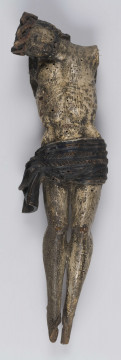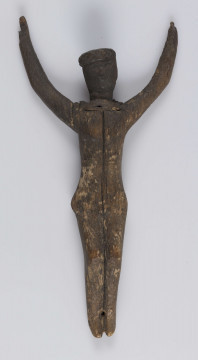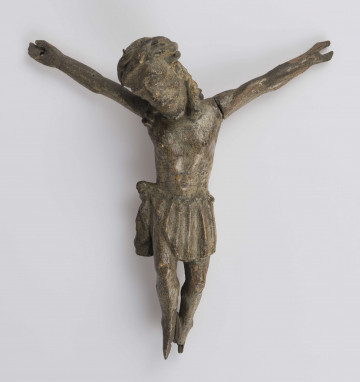
Christ Crucified
1801 — 1900
National Museum in Lublin
Part of the collection: Folk Art of the Lublin Region (17th–1st half of the 20th c.)
Roadside crosses are an inseparable element of the Polish landscape. This lonely sign has often marked the borders of "small fatherlands". It was erected on special occasions: on days of joy or at the time of mourning, in memory of the dead, as a prayerful sigh or to ask for a favour. It was meant to guard against danger, evil forces or to serve as a signpost. Situated among meadows and fields, it became an external expression of religious worship. It appeared at crossroads, on the borders of villages, settlements and towns, next to houses and farmsteads, in open fields and on the edge of forests, in clearings and thickets of woodland, alone or in groups, and in the company of chapels. It was erected on the sites of old churches and cemeteries, mass graves following the outbreak of plague, at the site of battles and skirmishes, the burial of heroes, at the site of a bloody crime, sudden death - for example from a lightning strike, or finding human bones. It could be found at the alleged site of a witch's burning, an apparition of the Virgin Mary or a saint.
In the Lublin area, as in the rest of Poland, many types of wooden crosses were erected. Some were simple, undecorated, others had carved knobs at the ends of the beams and a horseshoe-shaped tin roof with an openwork crest or the Passion insignia. On most of them the figure of Christ Crucified was placed. In the Lublin-Łęczyń crosses the space around the figure was additionally decorated with brackets, which took the form of a halo with gentle curves. In the districts of Biłgoraj and Janów we can still find picturesque examples of crosses with a roof, as if to protect the sculpture from rain or snow. There were also such crosses, the whole surface of which was covered with intricate woodcarving.
Tall crosses were carved from oak wood, while the figures were carved from linden or sycamore. They were often topped with small decorative iron crosses with a crescent and a cockerel on top. Almost all of them were engraved with inscriptions. Their content depended on the place, the circumstances in which they were erected and the intentions of the founder. They usually read: "God bless us", "You who suffered wounds for us, Jesus Christ have mercy on us", "From sudden death keep us Lord", "From air, hunger, fire and war - keep (save) us Lord".
Author / creator
Dimensions
cały obiekt: height: 26,5 cm
Object type
sculpture
Technique
sculpture
Material
wood
Creation time / dating
Creation / finding place
Owner
The National Museum in Lublin
Identification number
Location / status

1801 — 1900
National Museum in Lublin

1801 — 1900
National Museum in Lublin

1801 — 1900
National Museum in Lublin
DISCOVER this TOPIC
Museum of King Jan III's Palace at Wilanów
DISCOVER this PATH
Educational path